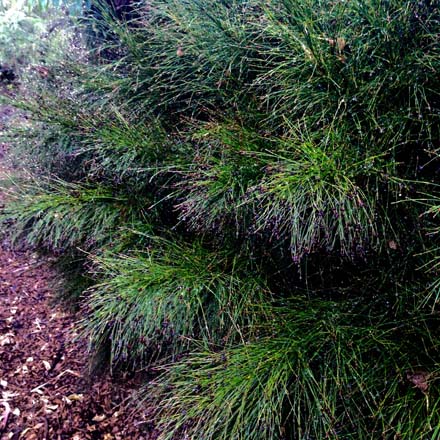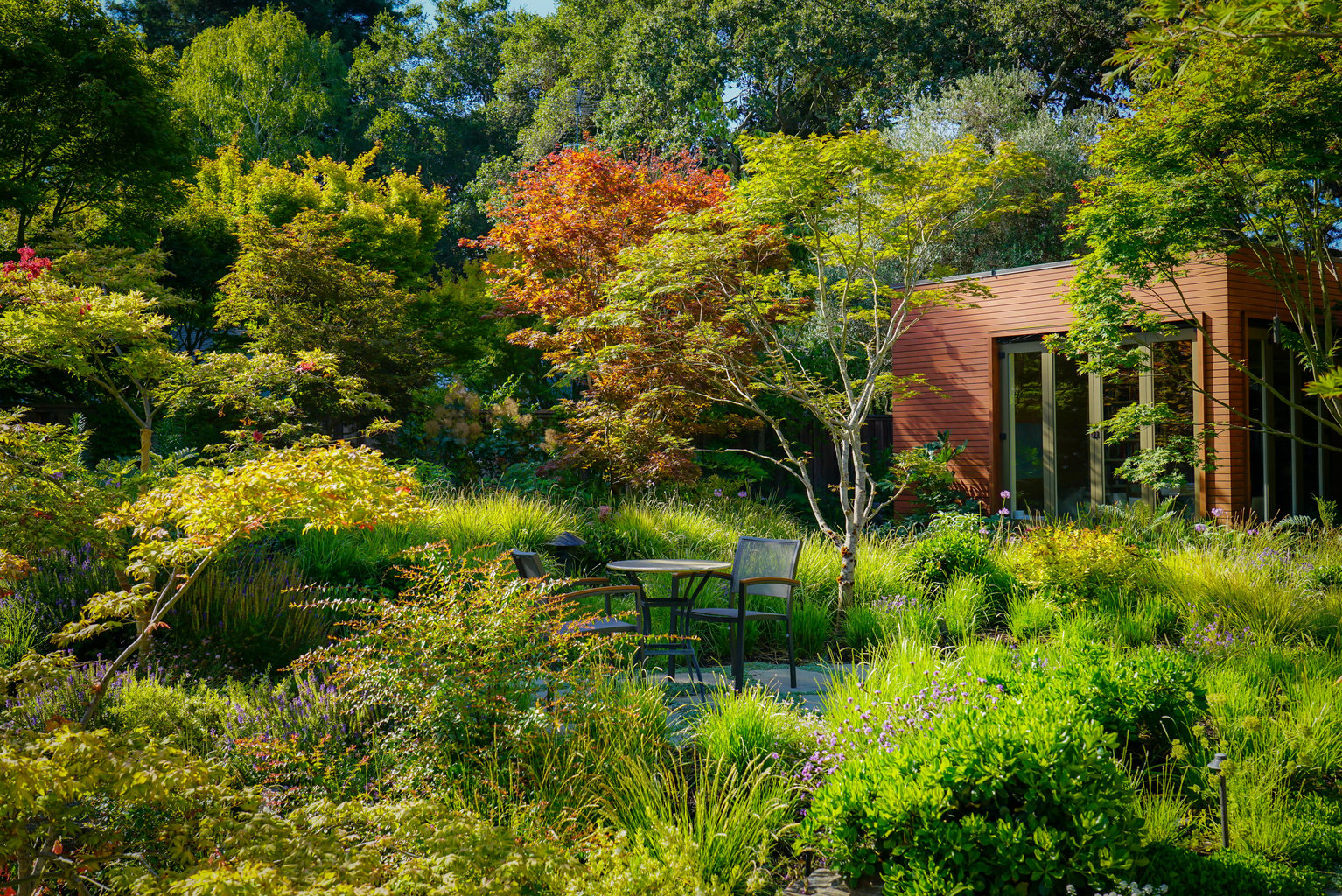
Restio Resource Guide

Contributor
- Topics: Plants You Need
California horticulturist Martin Grantham and Ginny Hunt, owner of Seedhunt.com, have conducted extensive growing trials and tested a variety of restios in California gardens. The following are some of their findings.

The following restios are both beautiful and generally useful in California gardens:
Askidiosperma paniculatum Drought- and shade-tolerant, soil adaptable, cascades in shade, upright in sun, long-lived, slow to mature, olive-green, unbranched culms, poor seed production so far in cultivation. Hardy to 10–20°F.
Elegia elephantina (formerly Chondropetalum elephantina) Drought-tolerant, soil adaptable, spreads moderately, long-lived, very easy to divide, introduced to California as the previous species, but distinguished by larger diameter culms and spreading habit. No damage reported at 20°F.
E. macrocarpa (formerly Chondropetalum macrocarpa) Drought- and shade-tolerant, spreads moderately, more soil testing needed, long-lived, blue-green culms and showy bracts. Hardy to 10–20°F.
E. tectorum (formerly Chondropetalum tectorum) Drought-tolerant, soil adaptable, long-lived, dark green unbranched culms, already widely planted. No damage reported at 20°F.
Restio quadratus Moderately drought-tolerant, shade-tolerant, soil adaptable, spreads moderately, extremely fine texture with annual regrowth at nodes for increasing fluff. Hardy to 20–25°F.
R. sieberi Drought-tolerant, soil adaptable. Hardy to 10–20°F.

R. subverticillata (formerly Ischyrolepis subverticillata) Shade-tolerant and moderately drought-tolerant, soil adaptable, dark green whorled branches added to each season. Some damage at 20°F.

Rhodocoma capensis Drought-tolerant, soil adaptable, dark green whorled, short branches added each season. No damage reported at 20°F.
Staberoha distachyos Drought-tolerant, soil adaptable, small size, moderate spread, male plant has attractive inflorescence. No damage at close to 20°F.
Thamnochortus fruticosus Moderately drought-tolerant, needs more soil testing but tolerates high pH, slow to moderate spread, easy to divide, remains densely branched through adult phase, small size. Hardy to 20–30°F.

T. insignis Drought-tolerant, soil adaptable, rapid transition from branching juvenile plants to unbranched mature phase, watch for invasive behavior. No damage reported at 20°F.
T. lucens Drought-tolerant, soil adaptable, moderate size, rapid transition from branched juvenile plants to unbranched mature phase, moderate size. Hardy to 10–20°F.
T. spicigerus Drought-tolerant, soil adaptable, spreads moderately. Hardy to 10–20°F.
The following unique restios require special conditions

Anthochortus crinalis High water requirements, but a fanciful container plant resembling a green Cousin It. Frost sensitive, but rhizomes are deep, surviving brief frosts in the ground to regrow and continue building its large green cushions through the summer. May attain the size of a recliner chair; in its mountain habitat it is sculpted by the wind into wonderful shapes. Not hardy

Cannomois grandis High water requirements, a striking plant but nutrient and pH sensitive (acidify soil with sulfur), the largest of all restios reaching 12 feet in suitable soils. New culms may have a strong red color. Entered cultivation as C. virgata, a name that now applies to a smaller, spreading species. No damage reported at 20°F.
C. scirpoides Grows on lower mountain slopes in the Klein Karoo where it experiences drought and possibly higher soil pH. Further testing may show it more adaptable. A hybrid swarm on Mt. Ararat in South Africa might yield hybrids that make a better California plant with the elegant form of C. grandis and the smaller size and drought tolerance of C. scirpoides. No damage at 25°F.
Thamnochortus acuminatus Slow to develop from seed but a long-lived and very nice-looking container plant with a silvery cast to the densely branched stems and stalked tassels. Large plants are easily divided and drought-tolerant. Hardy to 20–30°F.

The following more comprehensive list represents restios tested in California gardens by Martin Grantham and Ginny Hunt:
Anthochortus crinalis
Askidiosperma andreaeanum, A. chartaceum, A. esterhuyseniae, A. paniculatum
Cannomois congesta, C. grandis, C. parviflora, C. schlecteri, C. scirpoides, C. virgata
Elegia aggregata, E. caespitosa, E. capensis, E. coleura, E. cuspidata, E. ebracteata, E. elephantina, E. equisetacea, E. fenestrata, E. filacea, E. fistulosa, E. galpinii, E. grandis, E. grandispicata, E. hookeriana, E. intermedia, E. juncea, E. macrocarpa, E. mucronata, E. neesii, E. persistens, E. racemosa, E. stipularis, E. spathaceae, E. tectorum, E. tectorum dwf, E. thyrsoidea
Hydrophilos rattrayi
Hypodiscus laevigatus, H. striatus, H. synchroolepis
Platycaulos acutus, P. callistachyus
Restio arcuatus, R. bifarius, R. brachiatus, R. bruneus, R. dispar, R. festuciformis, R. leptostachys, R. levynsiae, R. multiflorus, R. nanus, R. ocreata, R. pachystachyus, R. paniculata, R. perplexus, R. quadratus, R. sieberi, R. similis, R. stokoei, R. strobilifer, R. subverticillata, R. venustulus, R. wittebergensis
Rhodocoma arida, R. capensis, R. fruticosa, R. gigantea, R. vleibergensis,
Staberoha aemula, S. banksii, S. cernua, S. distachyos, S. remota
Thamnochortus acuminatus, T. arenarius, T. bachmanii, T. cinereus, T. comptonii, T. erectus, T. fraternus, T. fruticosus, T. gracilis, T. insignis, T. lucens, T. muirii, T. nutans, T. pellucidus, T. platypteris, T. pluristachyus. T. pulcher, T. rigidus, T. schlechteri, T. spicigerus, T. sporadicus
Wildenowia incurvata
Plant and Seed Resources:
Share:
Social Media
Garden Futurist Podcast
Most Popular
Videos
Topics
Related Posts

Low Maintenance Gardens – Better for Pollinators and People
Autumn 2022 “I come out every day. It’s therapy, my meditation.” Janet’s young garden transformed from overgrown, invasive plants to mostly natives. The dailiness of

Invasive Plants Are Still Being Sold: Preventing Noxious Weeds in Your Landscape
Autumn 2022 With so many beautiful ornamental plant species and cultivars throughout California and the Pacific Northwest, how do you decide which ones to include

Garden Design in Steppe with Transforming Landscapes with Garden Futurist Emmanuel Didier
Summer 2022 Listen to full Garden Futurist: Episode XVII podcast here. Emmanuel Didier, Principal and Creative Director at Didier Design Studio is a leading figure

Seslerias: Versatile Groundcover Meadow Grasses
Summer 2022 Without question, the most beautiful and versatile of all the groundcover meadow grasses are the moor grasses (Sesleria). Moor grasses tick off all










Responses